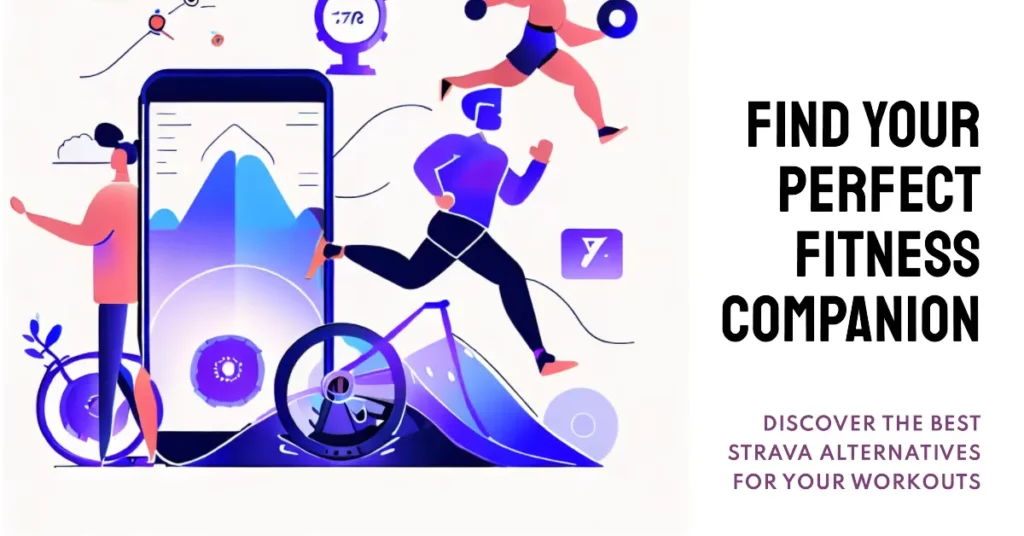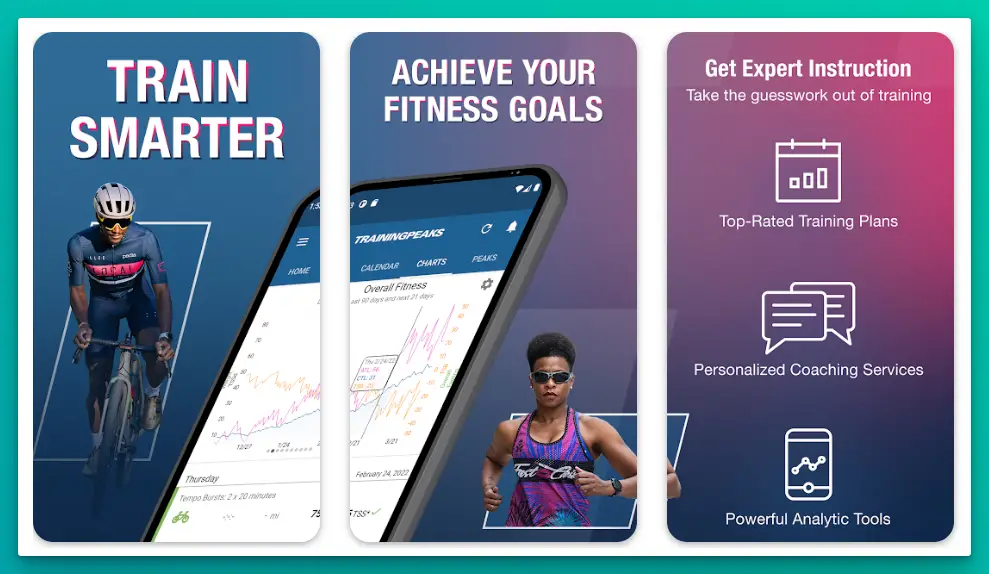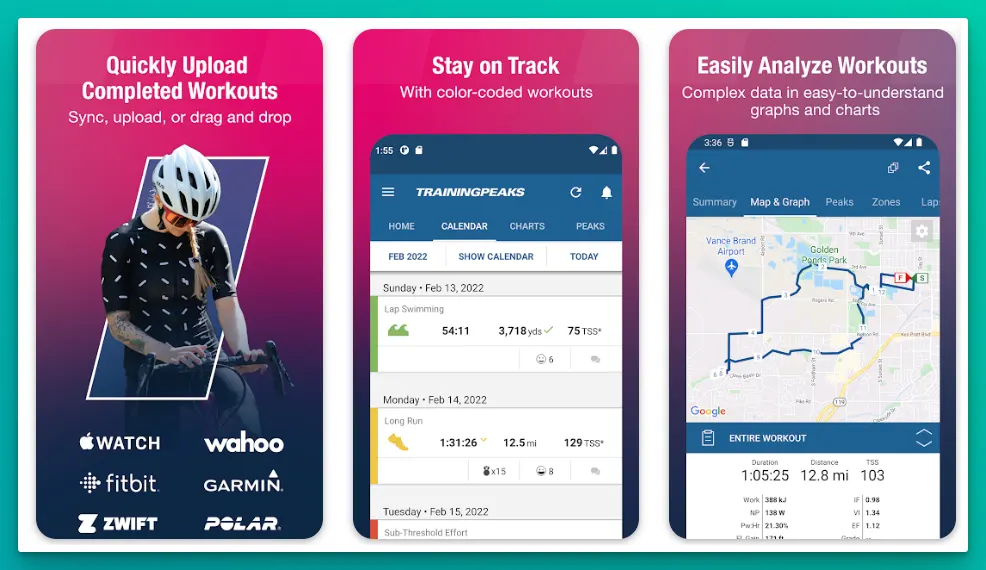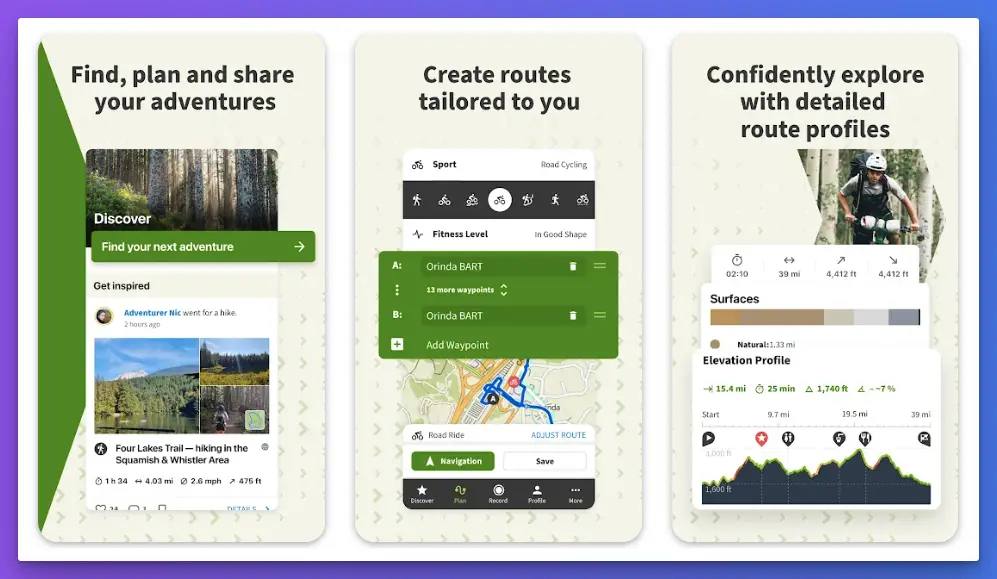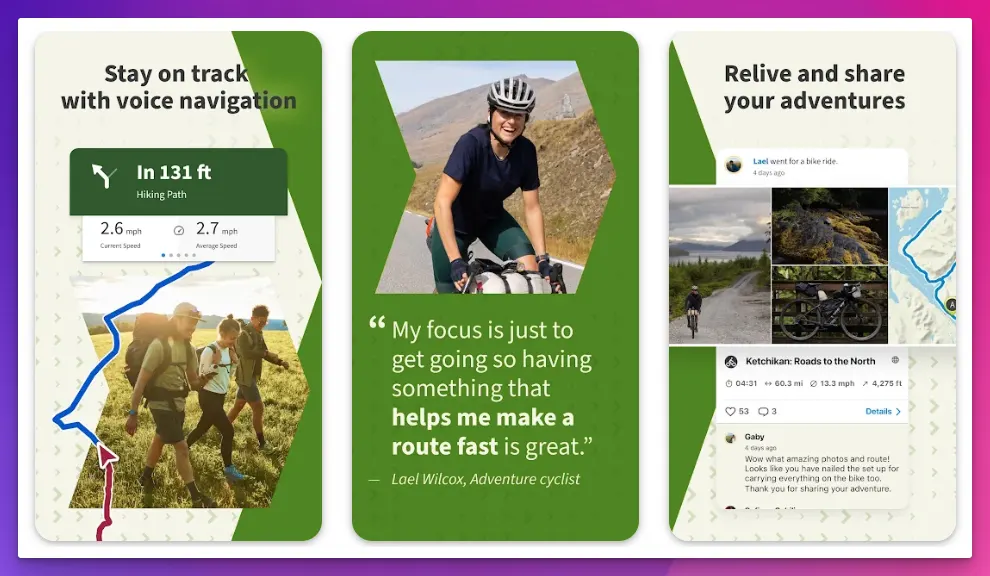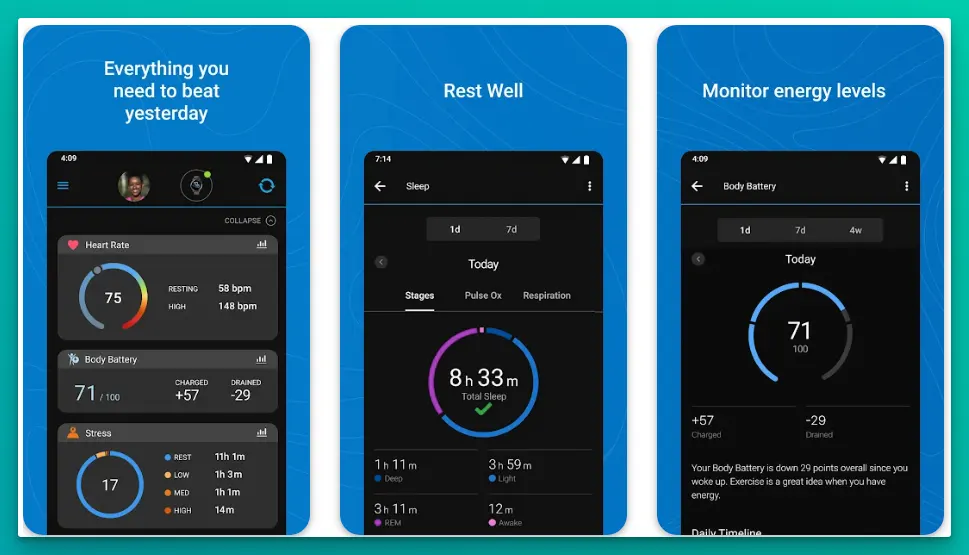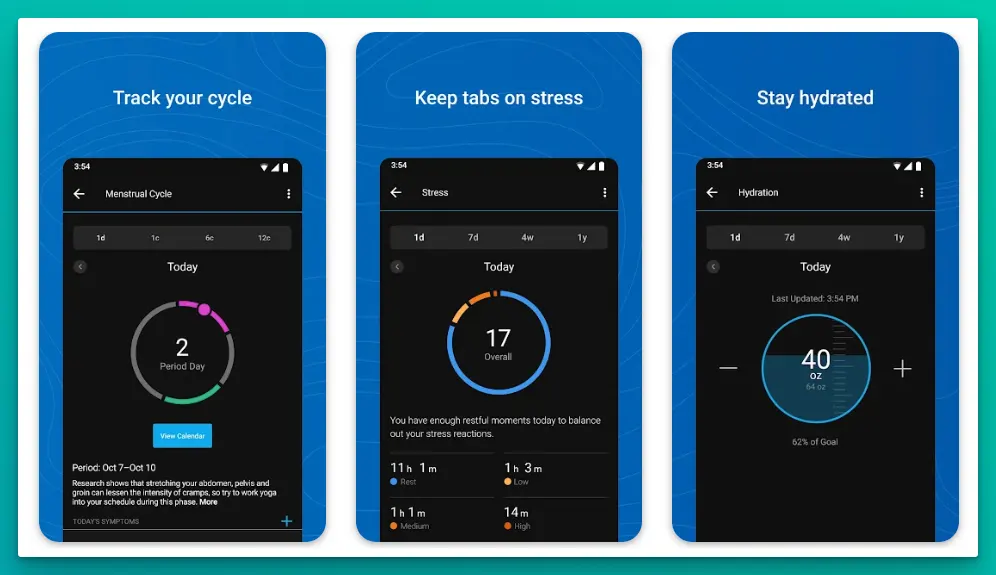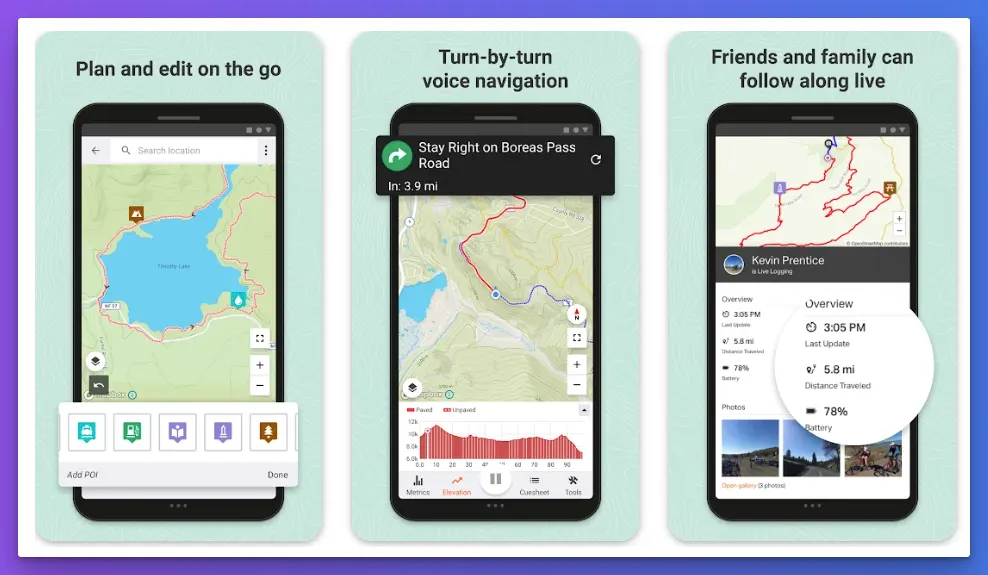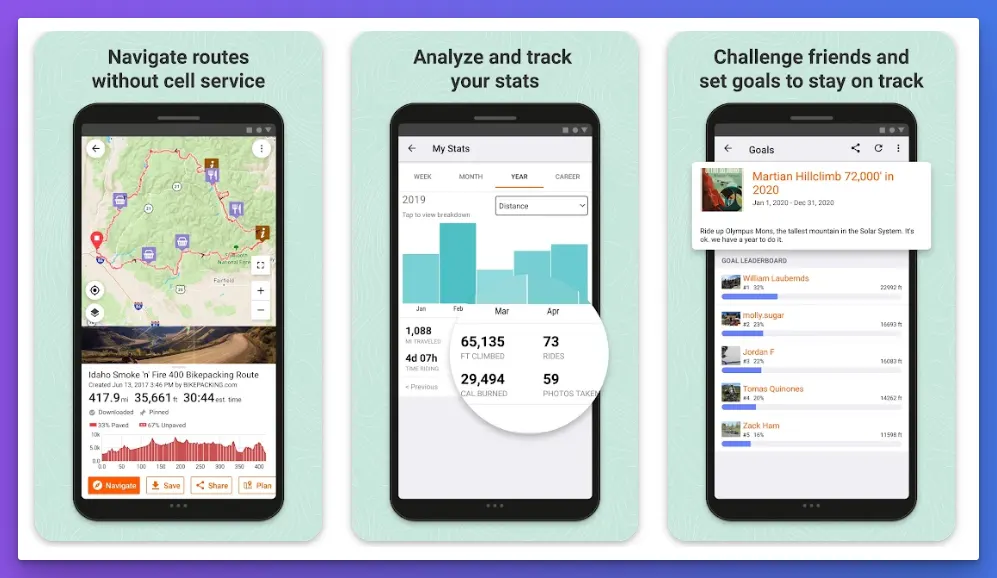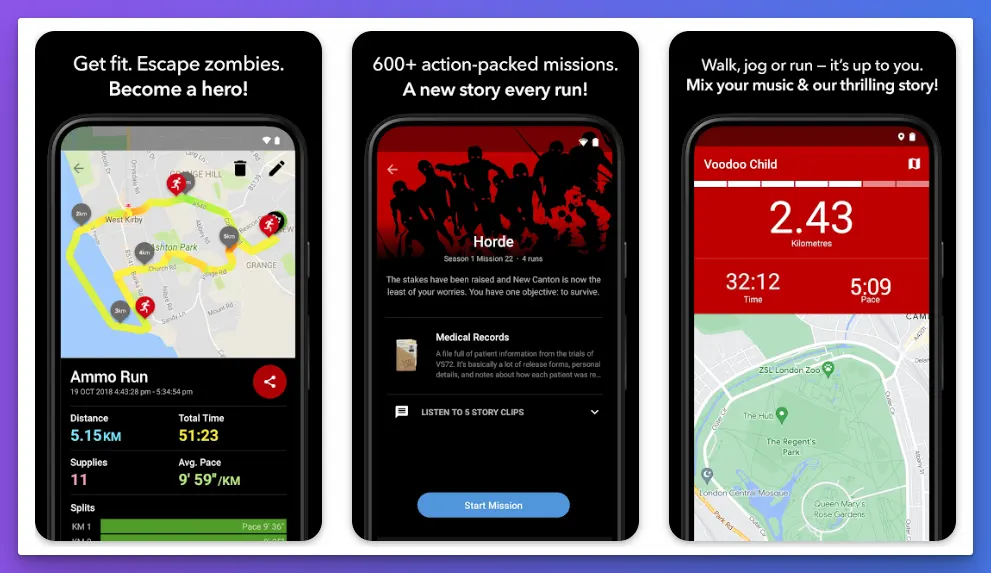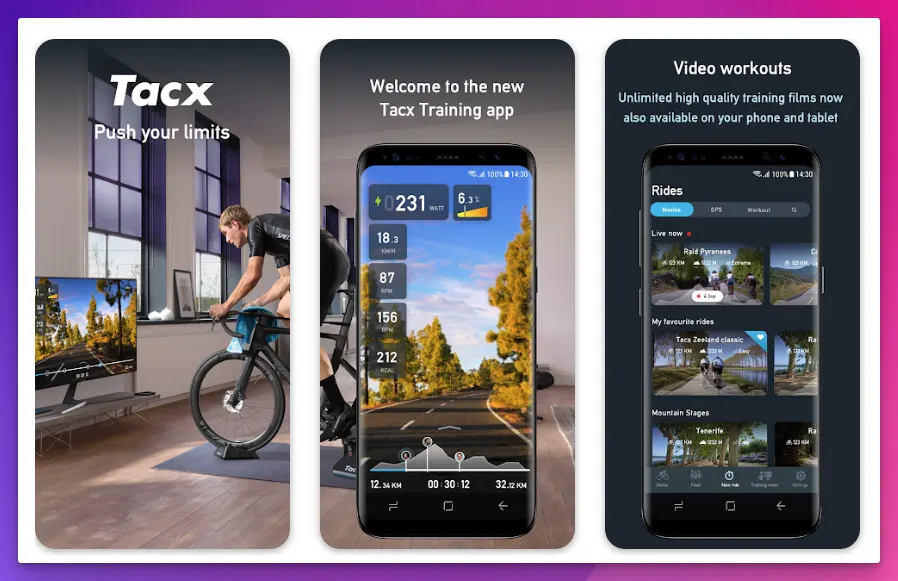Are you a fitness enthusiast looking for a different way to track your progress? Perhaps you’ve been using Strava for a while now, and while it’s packed with great features, you’re starting to wonder if there’s something else out there that might better suit your unique fitness goals.
There’s nothing more frustrating than feeling confined to one platform because it’s what you know, despite it not fully meeting your needs. Maybe Strava’s focus on competitive cycling and running isn’t what you want.
Or perhaps, you’re seeking a platform with a different social experience, more personal customization options, or simply a change in the user interface.
In our search for the best “Strava Alternatives,” we’ve dug into various fitness apps’ features, user ratings, and unique selling points. Whether you’re looking for a robust training planner or an app that’s more casual and social, we have some excellent options for you to consider.
Let’s dive in and find the perfect Strava alternative to help you take your fitness journey to the next level.
Factors to Consider when Choosing a Strava Alternative
In the vast landscape of fitness tracking and social running platforms, it’s crucial to carefully evaluate the factors to consider when choosing a Strava alternative. Selecting the right platform can significantly impact your fitness journey.
Let’s explore the key aspects you should take into account.
Compatibility is of utmost importance. Ensure the alternative seamlessly integrates with your preferred devices, such as smartwatches, fitness trackers, or smartphones. This ensures a smooth user experience and optimal data synchronization.
Privacy is a critical concern in today’s digital age. It’s essential to scrutinize the alternative’s privacy policies to secure your personal information and data. Look for platforms that offer robust privacy controls, allowing you to determine what information is shared and with whom.
Next, evaluate the available features. Look for alternatives offering extensive capabilities, such as high-precision GPS tracking, segment challenges, virtual races, and social interaction options. Consider your specific fitness goals and preferred activities to ensure the alternative caters to your needs.
The strength of a platform lies in its community. Seek alternatives that foster a vibrant and engaged community of like-minded individuals. A strong community provides motivation, support, and opportunities to connect and share experiences with fellow fitness enthusiasts.
An essential consideration is the alternative’s data analysis capabilities. Look for platforms that provide comprehensive analytical tools, including detailed activity insights, training metrics, and the ability to compare performance. These features enable you to gain valuable insights into your fitness journey and optimize your performance.
Lastly, factor in the cost. Evaluate the alternative’s pricing structure, considering the initial investment and ongoing subscription fees. Balance the features and value provided by the platform against your budgetary constraints.
By carefully considering these factors, you can confidently select a Strava alternative that aligns with your unique needs, empowering you to embark on a fulfilling fitness experience.
Top Strava Alternatives To Explore New Horizons
1. TrainingPeaks
Regarding finding a comprehensive fitness tracking and training platform, TrainingPeaks emerges as a strong contender as a Strava alternative. With its robust features and focus on optimizing training performance, TrainingPeaks offers a unique experience for athletes and fitness enthusiasts.
One notable advantage of TrainingPeaks is its emphasis on data-driven training. The platform allows users to meticulously plan and analyze their workouts, enabling them to make informed decisions and optimize their training regimens. TrainingPeaks provides a detailed understanding of performance metrics, from power-based training to heart rate zones.
TrainingPeaks also stands out in its versatility for various disciplines, including running, cycling, triathlon, and more. Whether you’re a beginner or an elite athlete, the platform offers personalized training plans and workout analyses tailored to your specific goals and abilities.
Integrating TrainingPeaks with popular fitness devices like Garmin allows for seamless data syncing. This enables athletes to effortlessly transfer their workout data and access it within the platform, streamlining the training process and providing a comprehensive overview of their progress.
Additionally, TrainingPeaks offers a coaching feature, making it an ideal choice for athletes seeking professional guidance. Coaches can create and monitor training plans, track progress, and provide valuable feedback to help athletes reach peak performance.
TrainingPeaks’ community aspect is another noteworthy aspect. The platform enables users to connect with fellow athletes, share workouts, and gain inspiration from a supportive network. This sense of camaraderie and accountability adds a layer of motivation to one’s training journey.
Regarding pricing, TrainingPeaks offers various subscription options to cater to different user needs. While the platform’s paid plans unlock advanced features, a free version is also available, providing a glimpse into the platform’s capabilities.
Overall, TrainingPeaks offers a compelling alternative to Strava, particularly for athletes looking to delve deeper into training analysis and receive personalized coaching.
Its focus on data-driven training, comprehensive integration with fitness devices, and vibrant community make it a valuable tool for achieving athletic success.
Pros:-
Data-Driven Training: TrainingPeaks offers in-depth analysis of performance metrics, allowing athletes to make informed training decisions based on data.
Versatility: The platform caters to various disciplines, including running, cycling, triathlon, and more, making it suitable for athletes with diverse training needs.
Integration with Fitness Devices: TrainingPeaks seamlessly syncs with popular fitness devices like Garmin, ensuring easy transfer of workout data and providing a comprehensive overview of progress.
Coaching Feature: The platform includes a coaching feature that allows athletes to connect with professional coaches, receive personalized training plans, and benefit from expert guidance.
Community Engagement: TrainingPeaks fosters a supportive community where users can connect with fellow athletes, share workouts, and draw inspiration from others.
Training Plan Customization: The platform enables athletes to create and customize training plans tailored to their goals, abilities, and specific training needs.
Cons:-
Less Social Interaction: Compared to Strava, TrainingPeaks places more emphasis on individual training analysis rather than social interaction with other users. This may be a drawback for athletes seeking a highly social and interactive platform.
Learning Curve: The extensive features and analysis tools offered by TrainingPeaks may have a steeper learning curve for new users compared to more simplified platforms.
Subscription-Based Pricing: While TrainingPeaks offers a free version, accessing advanced features and coaching services requires a subscription, which may be a consideration for athletes on a tight budget.
Focused on Serious Athletes: TrainingPeaks primarily targets serious athletes and individuals committed to structured training. Those seeking a more casual and recreational fitness experience may find the platform too advanced or complex for their needs.
Limited Activity Tracking Features: Compared to Strava, TrainingPeaks may offer fewer features specifically tailored to activity tracking, such as social challenges, leaderboards, and virtual competitions.
Individuals must weigh these pros and cons based on their preferences, training goals, and the features they prioritize when choosing between TrainingPeaks and Strava as fitness tracking platforms.
Suitable User Profile:-
TrainingPeaks is particularly well-suited for athletes and fitness enthusiasts who prioritize data-driven training, personalized coaching, and in-depth performance analysis.
The platform caters to individuals committed to structured training and seeking to optimize their training regimens for specific disciplines like running, cycling, triathlon, and more.
Ideal users for TrainingPeaks may include:
Serious Athletes: TrainingPeaks is designed to meet the needs of serious athletes dedicated to achieving their performance goals. It offers advanced features and in-depth training analysis to enhance their training experience.
Goal-Oriented Individuals: Users with specific goals, such as completing a marathon, improving their cycling power output, or competing in a triathlon, can benefit from TrainingPeaks’ ability to create personalized training plans and track progress.
Competitive Athletes: Those involved in competitive sports, either at the amateur or professional level, can utilize TrainingPeaks to optimize their training, analyze their performance metrics, and gain a competitive edge.
Athletes with Coaches: TrainingPeaks provides a platform for athletes who work with coaches. Coaches can create and monitor training plans, review workout data, and provide valuable feedback to their athletes, ensuring optimal training progress.
Data Enthusiasts: Users who appreciate the value of data-driven insights and enjoy analyzing their training metrics will find TrainingPeaks highly beneficial. The platform offers a range of tools for analyzing power, heart rate, pace, and other performance indicators.
Fitness Enthusiasts Seeking Structure: Individuals who prefer structured training programs and a systematic approach to their fitness routine will find TrainingPeaks valuable. The platform helps users organize and plan their workouts effectively.
While TrainingPeaks may not be as suitable for individuals seeking a highly social or recreational fitness platform, it caters to those motivated by data analysis, goal achievement, and personalized coaching.
Price:-
- Free with In-App Purchases
- One Month Premium Subscription$19.99
- One Year Premium Subscription$119.99
- Monthly Premium Subscription$19.99
- Annual Premium Subscription$124.99
- Quarterly Premium Subscription$48.99
Download The App From Google Play Store
Download The App From Apple App Store
2. Komoot – hike, bike & run
When exploring the great outdoors and discovering new trails, komoot emerges as a compelling Strava alternative. With its emphasis on route planning and navigation, komoot offers a unique experience for outdoor enthusiasts seeking adventure and exploration.
One of the standout features of komoot is its comprehensive route planning capabilities. The platform provides detailed maps and trail information, allowing users to create custom routes based on their preferred activities: hiking, biking, or running.
Users can tailor their routes to specific distances, difficulty levels, and terrain types, ensuring a personalized and enjoyable experience.
komoot’s navigation functionality sets it apart from traditional fitness tracking platforms. The app provides turn-by-turn directions and real-time guidance, enabling users to navigate confidently through unfamiliar trails and terrains. This feature is particularly useful for those who enjoy exploring new areas or exploring adventurous routes.
Another noteworthy aspect of komoot is its offline maps feature. Users can download maps in advance and access them without an internet connection, making it ideal for remote locations or areas with limited network coverage. This ensures outdoor enthusiasts can rely on the app’s navigation capabilities even in remote and off-grid locations.
Additionally, komoot offers a rich database of user-generated content. This includes detailed trail descriptions, ratings, and reviews from fellow outdoor enthusiasts. Users can benefit from the collective knowledge and experiences of the community, discovering hidden gems and popular routes recommended by others.
In terms of pricing, komoot offers both free and premium subscription options. While the free version provides basic features, the premium subscription unlocks additional features such as multi-day planning, sport-specific maps, and advanced route planning tools.
For outdoor enthusiasts seeking a platform focused on route planning, navigation, and exploring new trails, komoot is an excellent alternative to Strava. Its comprehensive features, offline map capabilities, and vibrant user community make it a valuable tool for outdoor adventurers.
Pros:-
Route Planning and Navigation: komoot provides comprehensive route planning tools and turn-by-turn navigation, allowing users to explore new trails and terrains confidently.
Customizable Routes: The platform enables users to create personalized routes based on their preferred activities, distance, difficulty level, and terrain type, ensuring a tailored outdoor experience.
Offline Maps: komoot’s offline maps feature allows users to download maps in advance and access them without an internet connection, making it suitable for remote areas or locations with the limited network coverage.
User-Generated Content: The platform benefits from a rich database of user-generated content, including trail descriptions, ratings, and reviews, providing valuable insights and recommendations from fellow outdoor enthusiasts.
Adventure and Exploration Focus: komoot is designed for outdoor adventurers who enjoy exploring new trails, discovering hidden gems, and embarking on unique routes.
Community Engagement: The platform fosters a vibrant community of outdoor enthusiasts, offering opportunities to connect, share experiences, and gain inspiration from like-minded individuals.
Cons:-
Limited Social Interaction: Compared to Strava, komoot places less emphasis on social features such as leaderboards, challenges, and the ability to connect with other users. It may be less appealing for those seeking a highly social and competitive platform.
Focused on Outdoor Activities: While komoot excels in providing features for outdoor activities like hiking, biking, and running, it may be less suitable for users looking for comprehensive tracking options for indoor workouts or gym-based activities.
Premium Subscription for Advanced Features: While komoot offers a free version with basic features, some advanced features, such as multi-day planning and sport-specific maps, require a premium subscription.
Learning Curve for New Users: The platform’s extensive features and route planning tools may have a learning curve for new users unfamiliar with outdoor navigation or mapping applications.
Device Compatibility: komoot is primarily designed for mobile devices and may not offer the same seamless experience on other platforms or devices, such as smartwatches or web browsers.
Individuals must consider these pros and cons based on their outdoor adventure preferences, route planning needs, and the features they prioritize when choosing between komoot and Strava as their preferred outdoor activity tracking platforms.
Suitable User Profile:-
komoot is well-suited for outdoor enthusiasts and adventurers who prioritize route planning, navigation, and exploration. The platform caters to individuals who enjoy discovering new trails, customizing their outdoor experiences, and seeking guidance while navigating unfamiliar terrains.
The ideal user profile for komoot includes the following:
Outdoor Adventurers: komoot is tailored for individuals who love outdoor activities such as hiking, biking, and running. It appeals to those who seek adventure, enjoy exploring new trails, and appreciate the beauty of nature.
Explorers and Trail Seekers: Users actively seeking new routes and trails will find komoot valuable. The platform’s route planning tools and user-generated content allow them to discover hidden gems and explore unfamiliar areas.
Solo Adventurers: komoot is suitable for individuals who prefer independent outdoor adventures. Its navigation and offline maps features provide confidence and guidance when exploring remote or off-grid locations alone.
Customization Enthusiasts: Users who enjoy tailoring their outdoor experiences will appreciate komoot’s customizable route options. The ability to choose distance, difficulty level, and terrain type allows them to create personalized adventures.
Outdoor Enthusiasts with Limited Network Coverage: komoot’s offline maps feature is beneficial for individuals who frequently venture into areas with the limited network coverage. They can rely on pre-downloaded maps and navigate seamlessly without an internet connection.
Nature Photographers: Photographers who enjoy capturing stunning landscapes and nature shots during their outdoor activities can use komoot to plan routes that take them through picturesque areas, ensuring memorable photo opportunities.
While komoot may have a narrower focus on outdoor activities compared to Strava, it caters to individuals who prioritize route planning, navigation, and exploring new trails.
Its user-friendly interface, community engagement, and emphasis on adventure make it a valuable tool for outdoor enthusiasts seeking unique outdoor experiences.
Price:-
- Free with In-App Purchases
- World Pack Welcome Offer$19.99
- World Pack$29.99
- Komoot Premium$59.99
- Komoot Premium$59.99
- World Pack$24.99
- World Pack Offer$19.99
- World Pack Welcome Offer$16.99
- World Pack Offer$16.99
- Komoot Premium$59.99
- Bay Area$6.99
Download The App From Google Play Store
Download The App From Apple App Store
3. Garmin Connect
Garmin Connect emerges as a formidable Strava alternative regarding fitness tracking and performance analysis. With its extensive features and integration with Garmin devices, Garmin Connect offers a comprehensive platform for athletes and fitness enthusiasts.
One of the key advantages of Garmin Connect is its seamless integration with a wide range of Garmin devices. Garmin Connect provides a unified ecosystem for tracking and analyzing various activities, from GPS-enabled smartwatches to advanced cycling computers. This integration ensures accurate data collection and synchronization, enhancing the fitness-tracking experience.
Garmin Connect excels in data analysis and performance insights. The platform provides detailed metrics, including heart rate, cadence, power, and more.
Athletes can analyze performance trends, set personalized goals, and monitor progress. This data-driven approach enables users to make informed training decisions and optimize performance.
The social aspect of Garmin Connect fosters a sense of community and motivation. Users can connect with friends, join challenges, and participate in virtual races. This interactive feature allows athletes to share achievements, compete with others, and draw inspiration from the Garmin Connect community.
Garmin Connect also offers comprehensive training plans and workout suggestions. Users can access pre-designed training programs or create customized plans tailored to their goals and preferences. The platform guides intensity, duration, and recovery, helping athletes structure their training effectively.
Additionally, Garmin Connect offers insights on overall wellness. Beyond fitness tracking, the platform provides sleep analysis, stress monitoring, and hydration tracking features. This holistic approach enables users to understand their overall health better and make lifestyle adjustments accordingly.
While Garmin Connect is primarily tailored for Garmin device users, it provides a robust and feature-rich fitness tracking, data analysis, and community engagement platform.
Its integration with Garmin devices, extensive data insights, training plans, and focus on overall wellness makes it a compelling alternative to Strava for athletes and fitness enthusiasts.
Pros:-
Seamless Integration with Garmin Devices: Garmin Connect’s compatibility with a wide range of Garmin devices ensures accurate data collection and synchronization, providing a comprehensive fitness tracking experience.
Extensive Data Analysis: Garmin Connect offers detailed metrics and performance insights, including heart rate, cadence, power, and more. Athletes can analyze data, track trends, and make informed training decisions to optimize performance.
Community and Social Features: The social aspect of Garmin Connect allows users to connect with friends, join challenges, and participate in virtual races. This fosters community, motivation, and friendly competition among users.
Comprehensive Training Plans: Garmin Connect provides access to pre-designed training plans and offers the flexibility to create customized plans tailored to individual goals and preferences. Users can receive intensity, duration, and recovery guidance to structure their training effectively.
Overall Wellness Monitoring: Besides fitness tracking, Garmin Connect offers insights on overall wellness, including sleep analysis, stress monitoring, and hydration tracking. This holistic approach helps users understand their overall health and make lifestyle adjustments accordingly.
Cons:-
Device Dependence: Garmin Connect’s seamless integration primarily caters to Garmin device users. Those without Garmin devices may find limited compatibility or be unable to utilize all platform features fully.
Less Social Interaction: Compared to Strava, Garmin Connect’s social features may be less robust and engaging for users seeking a highly interactive and socially-driven fitness community.
Learning Curve for New Users: Garmin Connect’s extensive features and settings may have a learning curve for new users unfamiliar with the platform or Garmin devices.
Limited Non-Fitness Features: While Garmin Connect offers insights on overall wellness, it may have fewer non-fitness features than Strava, such as nutrition tracking or mental well-being resources.
Subscription Costs: While Garmin Connect offers a basic free version, some advanced features, and premium services may require a subscription or additional costs.
Users should consider these pros and cons based on their device compatibility, preference for social features, training needs, and overall wellness goals when considering Garmin Connect as an alternative to Strava.
Suitable User Profile:-
Garmin Connect caters to diverse users, particularly those who prioritize accurate fitness tracking, data analysis, and integration with Garmin devices. The platform is well-suited for individuals serious about their training, seeking comprehensive performance insights, and valuing the benefits of using Garmin devices.
The ideal user profile for Garmin Connect includes the following:
Garmin Device Users: Garmin Connect is most suitable for individuals who own Garmin devices such as GPS-enabled smartwatches, cycling computers, or fitness trackers. These users can fully leverage the seamless integration and compatibility offered by Garmin Connect.
Fitness Enthusiasts and Athletes: Users who are dedicated to their fitness goals and seek detailed data analysis and performance insights will find Garmin Connect valuable. The platform provides in-depth metrics and trend analysis to help athletes track progress and optimize training.
Data-Driven Individuals: Garmin Connect appeals to users who appreciate the power of data and enjoy analyzing their performance metrics. These individuals find motivation in tracking their progress and using data to make informed decisions for their training.
Community-Oriented Athletes: While not as socially focused as Strava, Garmin Connect’s community features offer opportunities to connect with friends, participate in challenges, and engage in virtual races. Users seeking a supportive community to share achievements and compete with others will find value in these features.
Wellness-Minded Individuals: Garmin Connect’s holistic approach to wellness, with features like sleep analysis, stress monitoring, and hydration tracking, benefits users who prioritize overall health and well-being.
Training Plan Seekers: Individuals who prefer structured training plans and guidance will appreciate Garmin Connect’s comprehensive training plans and workout suggestions. The platform helps users structure their training effectively and guides intensity, duration, and recovery.
While Garmin Connect may have some limitations, its focus on accurate data tracking, advanced metrics, integration with Garmin devices, and community engagement make it an ideal choice for fitness enthusiasts, athletes, and data-driven individuals who value performance insights and seek a comprehensive training experience.
Price:-
- Free
Download The App From Google Play Store
Download The App From Apple App Store
Ride with GPS is a compelling Strava alternative for cyclists seeking a robust and feature-rich platform. With its focus on route planning, navigation, and in-depth cycling analytics, Ride with GPS offers a comprehensive experience for cycling enthusiasts.
One of the key strengths of Ride with GPS is its route planning capabilities. The platform enables users to create custom routes based on their preferred distance, elevation, and terrain. Cyclists can explore new roads, discover scenic routes, and tailor their rides to their preferences.
Ride with GPS excels in navigation features, providing turn-by-turn directions and real-time voice prompts to guide cyclists along their planned routes. This ensures a seamless and stress-free riding experience, especially in unfamiliar areas or complex intersections.
The platform’s cycling analytics is another standout feature. Ride with GPS offers in-depth performance metrics, including speed, cadence, heart rate, and power data, allowing cyclists to analyze their rides in detail. This data-driven approach helps athletes monitor their progress, identify areas for improvement, and set new goals.
Ride with GPS also fosters a vibrant cycling community. Users can share their rides, join clubs, and participate in challenges. This social aspect encourages camaraderie, competition, and the exchange of experiences among cyclists.
In terms of pricing, Ride with GPS offers both free and premium subscription options. The premium subscription unlocks additional features, including advanced mapping tools, offline maps, and enhanced analysis tools.
While Strava may have a broader scope beyond cycling, Ride with GPS caters specifically to cyclists, offering comprehensive route planning, navigation, detailed analytics, and a thriving cycling community. For cycling enthusiasts seeking a platform tailored to their needs, Ride with GPS is an excellent alternative to Strava.
Pros:-
Comprehensive Route Planning: Ride with GPS offers robust route planning tools, allowing cyclists to create custom routes based on distance, elevation, and terrain preferences. This enables riders to explore new roads and discover scenic routes.
Turn-by-Turn Navigation: The platform provides turn-by-turn directions and real-time voice prompts, ensuring cyclists can easily navigate their planned routes, especially in unfamiliar areas or complex intersections.
Detailed Cycling Analytics: Ride with GPS offers in-depth performance metrics, including speed, cadence, heart rate, and power data. Cyclists can analyze their rides, monitor progress, and identify areas for improvement to enhance their performance.
Vibrant Cycling Community: Ride with GPS fosters a thriving cycling community where users can share their rides, join clubs, and participate in challenges. This social aspect encourages camaraderie, competition, and the exchange of experiences among cyclists.
Premium Features: While Ride with GPS offers a free version, the premium subscription unlocks additional features, including advanced mapping tools, offline maps, and enhanced analysis tools, providing added value to users.
Cons:-
Limited Multisport Tracking: Ride with GPS focuses primarily on cycling and may not offer the same breadth of features for other sports and activities as Strava.
Less Diverse Social Features: While Ride with GPS has a vibrant cycling community, it may have fewer social features than Strava, such as leaderboards, segment challenges, and overall fitness tracking for various activities.
Learning Curve for New Users: The platform’s extensive features and settings may have a learning curve for new users unfamiliar with ride planning, navigation, or cycling-specific data analysis.
Device Compatibility: Users should ensure compatibility with their preferred devices and operating systems, as Ride with GPS may have limitations or varying functionality across different devices and platforms.
Subscription Costs: While Ride with GPS offers a free version, certain premium features and advanced tools require a subscription, which may be a consideration for users on a budget.
Cyclists should consider these pros and cons based on their specific needs, cycling focus, and preferences when choosing Ride with GPS and Strava as their preferred cycling tracking and analysis platform.
Suitable User Profile:-
Ride with GPS caters to a specific niche of cyclists who prioritize comprehensive route planning, navigation, and detailed cycling analytics. The platform is well-suited for individuals passionate about cycling and seeking a dedicated platform tailored to their needs.
The ideal user profile for Ride with GPS includes the following:
Cycling Enthusiasts: Ride with GPS is designed for individuals with a deep passion for cycling. These users enjoy exploring new routes, discovering scenic roads, and customizing their rides based on distance, elevation, and terrain preferences.
Route Explorers: Cyclists who actively seek new routes and enjoy the thrill of discovering lesser-known roads and trails will find Ride with GPS valuable. The platform’s robust route planning tools empower users to explore and expand their cycling horizons.
Navigation-Dependent Riders: Cyclists who frequently venture into unfamiliar areas or complex road networks can rely on Ride with GPS’s turn-by-turn navigation. The platform provides real-time voice prompts to ensure seamless navigation and prevent getting lost during rides.
Data-Driven Cyclists: Users who are data enthusiasts and enjoy analyzing their cycling performance will appreciate Ride with GPS’s detailed analytics. The platform offers in-depth metrics, including speed, cadence, heart rate, and power data, allowing cyclists to track their progress, set goals, and optimize their performance.
Community-Engaged Riders: Ride with GPS’s vibrant cycling community appeals to cyclists who value interaction, camaraderie, and the opportunity to connect with like-minded individuals. Users can share their rides, join clubs, and participate in challenges to engage with the cycling community.
While Ride with GPS may focus more on cycling than Strava, it provides a feature-rich platform specifically designed for cyclists. Cyclists prioritizing route planning, navigation, detailed analytics, and community engagement will find Ride with GPS a valuable alternative to Strava.
Price:-
- Free with In-App Purchases
- Basic$7.99
- Basic$59.99
- Premium$9.99
- Premium$9.99
- Basic – Non-renewing$3.99
- Premium$79.99
- 7 Day Subscription$3.99
- Premium$79.99
Download The App From Google Play Store
Download The App From Apple App Store
5. Zombies, Run!
For those seeking a unique and immersive fitness experience, Zombies, Run! emerges as an exciting Strava alternative. Blending storytelling, gamification, and fitness tracking, Zombies, Run! offers a thrilling and interactive way to stay motivated and active.
At its core, Zombies, Run! is an immersive running app that transforms your workouts into a thrilling zombie survival adventure.
As you run, you listen to an audio story that unfolds with each step, making you feel like you’re part of a post-apocalyptic world filled with zombies. The app integrates with your music library, allowing you to enjoy your favorite tunes while the story progresses.
The gamification element of Zombies, Run! sets it apart from traditional fitness tracking apps. You’re assigned missions to complete, where you collect supplies, rescue survivors, and evade the pursuit of zombies. The more you run, the more progress you make in the story, unlocking new missions and uncovering the secrets of the zombie-infested world.
Zombies, Run! also tracks essential fitness data, including distance, pace, and calories burned. This allows you to monitor your running progress and track improvements over time. The app encourages you to push further to outrun the virtual zombie hordes.
The unique blend of storytelling, gamification, and fitness tracking makes Zombies, Run! an appealing alternative to Strava for those who enjoy a more engaging and immersive fitness experience.
It offers a fresh perspective on running, injecting excitement and motivation into each workout session. So, lace up your running shoes, embrace the zombie apocalypse, and let Zombies, Run! turn your fitness routine into an exhilarating adventure.
Pros:-
Immersive Storytelling: Zombies, Run! offers a unique, immersive storytelling experience that makes running more engaging and exciting. The audio story unfolds as you run, creating a thrilling zombie survival adventure.
Gamification and Motivation: The app incorporates gamification elements by assigning missions and allowing you to collect supplies, rescue survivors, and evade zombies. This adds an element of fun and motivation to your workouts.
Integration with Music: Zombies, Run! integrates with your music library, allowing you to enjoy your favorite tunes while immersing yourself in the story. This enhances the overall experience and keeps you entertained during your runs.
Fitness Tracking: The app tracks essential fitness data such as distance, pace, and calories burned. This allows you to monitor your running progress and track improvements over time, providing a sense of accomplishment.
Engaging Community: Zombies, Run! has an active and supportive community of users who share their experiences and achievements. It provides a sense of community and connection, fostering motivation and camaraderie.
Cons:-
Limited Activity Tracking: While Zombies, Run! focuses on running, it may have limited tracking features for other activities or sports. It may not provide the same comprehensive tracking and analysis level as dedicated fitness tracking apps like Strava.
Story-Driven Focus: The immersive storytelling aspect may not appeal to users who prefer a more data-driven or competitive fitness experience. If you prioritize leaderboards, challenges, or in-depth performance analysis, Zombies, Run! may not fulfill those specific needs.
Learning Curve for New Users: The app has a learning curve for new users unfamiliar with the interactive storytelling format or gamified fitness tracking. Understanding and fully enjoying the app’s features may take some time.
Device Compatibility: Users should ensure compatibility with their preferred devices and operating systems, as Zombies, Run! may have limitations or varying functionality across different devices and platforms.
While Zombies, Run! offers a distinct and immersive fitness experience, it may not cater to all fitness tracking needs. Users should consider these pros and cons based on their preferences for storytelling, gamification, and community engagement when choosing Zombies, Run! and Strava as their preferred fitness tracking apps.
Suitable User Profile:-
Zombies, Run! caters to individuals who seek a unique and immersive fitness experience that combines storytelling, gamification, and running. The app is well-suited for those who enjoy an interactive, thrilling workout session.
The ideal user profile for Zombies, Run! includes the following:
Storytelling Enthusiasts: Users who appreciate immersive storytelling will find Zombies, Run! appealing. If you enjoy being transported into a post-apocalyptic world and experiencing thrilling narratives during your runs, this app is perfect for you.
Gamification Fans: Individuals motivated by gamification and enjoying the challenge of completing missions will find Zombies, Run! engaging. The app’s gamified elements, such as collecting supplies and evading virtual zombies, add excitement and motivation to their workouts.
Novelty Seekers: Users looking for a fresh, unique fitness experience that deviates from traditional workout apps will appreciate Zombies, Run! The app offers a refreshing approach to running by incorporating elements of entertainment and adventure.
Music Lovers: If you enjoy running with music and want to combine it with an immersive story, Zombies, Run! is a great fit. The app seamlessly integrates with your music library, allowing you to enjoy your favorite tunes while immersing yourself in the thrilling storyline.
Social Community Participants: Zombies, Run! has an active community of users who share their experiences, achievements, and progress. The app provides an engaging social platform if you enjoy connecting with like-minded individuals, participating in challenges, and sharing your adventures.
While Zombies, Run! may not cater to individuals seeking extensive fitness tracking or competitive features, it offers a unique blend of storytelling, gamification, and running.
Users who value entertainment, motivation, and an immersive fitness experience will find Zombies, Run! a suitable alternative to Strava.
Price:-
- Free with In-App Purchases
- Abel Runner’s Club$5.99
- Abel Runner’s Club$39.99
- Abel Runner’s Club (Legacy)$19.99
Download The App From Google Play Store
Download The App From Apple App Store
6. Zwift
For fitness enthusiasts seeking a dynamic and immersive indoor training experience, Zwift stands out as an impressive Strava alternative. With its virtual cycling and running platform, Zwift offers an interactive and engaging way to stay active and connected in the comfort of your home.
At its core, Zwift is a virtual training app that allows users to ride or run in a virtual world. Users can participate in virtual races, group rides, and structured workouts by connecting their indoor trainers or treadmills to the app. The platform combines the thrill of outdoor activities with the convenience and accessibility of indoor training.
Zwift provides a visually stunning and highly realistic virtual environment where users can explore different worlds, complete challenges, and track progress. The app offers various terrains, from scenic mountain routes to bustling city streets, providing variety and excitement in each session.
One of the key advantages of Zwift is its strong focus on community and social interaction. Users can ride or run alongside other virtual athletes, join group workouts, and compete in races.
The app also features a chat function, allowing users to connect with fellow participants worldwide, fostering a sense of camaraderie and motivation.
Zwift integrates with popular fitness tracking devices and platforms, enabling users to sync their activities to platforms like Strava for comprehensive tracking and analysis. This integration allows users to enjoy the immersive experience of Zwift while still having their performance data recorded and shared.
Whether you’re a dedicated cyclist or runner looking for an engaging indoor training solution or seeking the excitement of virtual races and social interaction, Zwift is an exceptional alternative to Strava.
Its immersive virtual world, interactive features, and strong community engagement make Zwift a powerful tool for indoor fitness enthusiasts.
Pros:-
Immersive Virtual Environment: Zwift provides a visually stunning and highly realistic virtual environment that adds excitement and engagement to indoor training sessions. Users can explore various terrains, creating a dynamic and immersive experience.
Virtual Group Rides and Races: Zwift allows users to participate in virtual group rides and races, offering a sense of competition and camaraderie. Users can join organized events or create their own, enhancing motivation and social interaction.
Structured Workouts: The platform offers structured workouts designed by professional coaches, catering to users of different fitness levels and goals. This helps users follow a training plan, improve performance, and stay motivated during indoor sessions.
Community and Social Interaction: Zwift fosters a strong sense of community, enabling users to connect with fellow athletes worldwide. The chat function and group workouts encourage social interaction, creating a supportive and motivating environment.
Integration with Fitness Tracking Platforms: Zwift integrates with popular fitness tracking devices and platforms, allowing users to sync their activities with platforms like Strava for comprehensive tracking and analysis. This enables users to have a complete overview of their training progress.
Cons:-
Indoor Training Focus: Zwift is primarily designed for indoor cycling and running, limiting its suitability for users who prefer outdoor activities or multi-sport tracking. It may not provide the same breadth of features for other sports as dedicated platforms like Strava.
Equipment and Cost: Zwift requires compatible indoor trainers or treadmills, which can be an additional investment. Moreover, while the platform offers a free trial period, a subscription fee is required to access the full range of features, which may not be appealing to all users.
Learning Curve: Zwift has a learning curve for new users, particularly in setting up the equipment and understanding the interface. Users may need to familiarize themselves with the platform and its features to optimize their experience fully.
Dependence on Internet Connectivity: Zwift requires a stable internet connection for a smooth and uninterrupted experience. Users in areas with unreliable or limited internet access may face challenges when using the platform.
Limited Outdoor Tracking: Zwift offers some outdoor training features but primarily focuses on indoor training. Users seeking comprehensive outdoor tracking, including GPS-based activities, may find dedicated outdoor tracking apps like Strava more suitable.
Individuals should consider these pros and cons based on their preferences, fitness goals, and training environment when considering Zwift as an alternative to Strava.
Suitable User Profile:-
Zwift caters to diverse users passionate about indoor training, virtual racing, and community engagement. The platform is well-suited for individuals seeking an immersive and interactive indoor fitness experience.
The ideal user profile for Zwift includes the following:
Indoor Training Enthusiasts: Zwift is designed for individuals who enjoy training indoors and want to add excitement and engagement to their workouts. Users who prefer the convenience, controlled environment, and variety of indoor training will find Zwift appealing.
Cyclists and Runners: Zwift suits cyclists and runners who want to replicate outdoor experiences indoors. Whether for maintaining fitness during inclement weather or incorporating virtual racing and structured workouts into their training regimen, Zwift provides a dynamic platform for these activities.
Virtual Racing and Competition Seekers: Users who thrive on competition and enjoy virtual racing will find Zwift captivating. The platform offers opportunities to participate in group rides, races, and challenges, providing a sense of camaraderie and motivation.
Socially-Engaged Fitness Enthusiasts: Zwift’s strong focus on community and social interaction appeals to individuals who enjoy connecting with like-minded athletes. Users who value the encouragement and support of a virtual community will find Zwift’s chat function, group workouts, and events beneficial.
Tech-Savvy Individuals: Users who embrace technology and enjoy integrating their fitness tracking devices and platforms will appreciate Zwift’s seamless integration with popular fitness tracking platforms like Strava. This allows for comprehensive tracking and analysis of indoor training sessions.
While Zwift may specifically focus on indoor training and virtual racing, it offers cyclists and runners an immersive and interactive fitness experience.
Users who prioritize indoor training, virtual racing, community engagement, and the desire to recreate outdoor experiences indoors will find Zwift a suitable alternative to Strava.
Price:-
- Free with In-App Purchases
- Zwift Premeium $14.99
Download The App From Google Play Store
Download The App From Apple App Store
7. Tacx Training
For cyclists and indoor training enthusiasts, Tacx Training serves as an exceptional Strava alternative. With its advanced features and focus on indoor cycling, Tacx Training provides a comprehensive platform to enhance training sessions and track progress.
Tacx Training offers various virtual training options, allowing users to immerse themselves in virtual rides and workouts. The app provides access to a vast library of high-quality video routes, allowing cyclists to experience realistic outdoor rides from the comfort of their indoor trainers.
One of the key strengths of Tacx Training is its smart trainer compatibility. The app seamlessly integrates with smart trainers, enabling automatic resistance adjustments based on the virtual route or structured workout. This dynamic interaction enhances the realism and intensity of indoor cycling sessions.
Tacx Training also offers structured workouts designed by professional coaches. These workouts cater to various training goals, such as endurance, intervals, or specific power targets. Users can choose from various training plans or create customized workouts to optimize their training sessions.
The app’s real-time data display gives cyclists essential metrics, including power, cadence, speed, and heart rate. This data allows users to monitor performance, track improvements, and make informed training decisions.
Tacx Training provides a social platform where users can connect with other cyclists, join group rides, and participate in virtual races. This community aspect adds motivation and a sense of camaraderie to indoor training sessions.
While Tacx Training primarily focuses on indoor cycling, its virtual training options, smart trainer compatibility, structured workouts, and social features make it an appealing alternative to Strava for cyclists who prioritize indoor training and performance tracking.
Pros:-
Virtual Training Experience: Tacx Training offers a realistic and immersive virtual training experience, allowing cyclists to ride virtual routes and experience outdoor rides from the comfort of their indoor trainers.
Smart Trainer Compatibility: The app integrates with smart trainers, providing automatic resistance adjustments based on virtual routes or structured workouts. This dynamic interaction enhances the realism and intensity of indoor cycling sessions.
Structured Workouts: Tacx Training provides a variety of structured workouts designed by professional coaches. Users can choose from pre-designed training plans or create customized workouts to meet their training goals.
Real-time Data Display: The app displays essential real-time metrics, including power, cadence, speed, and heart rate. This data allows cyclists to monitor their performance, track improvements, and make informed training decisions.
Social Features: Tacx Training offers a social platform where users can connect with other cyclists, join group rides, and participate in virtual races. This fosters community, motivation, and friendly competition among users.
Cons:-
Limited Outdoor Tracking: Tacx Training primarily focuses on indoor cycling and may have limited outdoor activity tracking features. Users who prefer outdoor tracking and multi-sport functionalities may find dedicated outdoor tracking apps like Strava more suitable.
Indoor Training Focus: While Tacx Training excels in providing an immersive indoor training experience, it may not cater to individuals who prefer a more diverse range of outdoor activities or who seek comprehensive tracking and analysis for non-cycling activities.
Equipment Dependence: Tacx Training requires compatible smart trainers or indoor cycling equipment for optimal use. Users who do not have access to such equipment may not be able to utilize the app’s features fully.
Learning Curve for New Users: The app may have a learning curve for new users unfamiliar with virtual training platforms or smart trainer integration. Users may need to invest time in understanding the features and settings of the app.
Subscription Costs: While Tacx Training offers a basic free version, some advanced features, and premium services may require a subscription or additional costs.
Users should consider these pros and cons based on their preference for indoor cycling, smart trainer compatibility, structured workouts, and social features when considering Tacx Training as an alternative to Strava.
Suitable User Profile:-
Tacx Training caters to a specific group of users passionate about indoor cycling, virtual training, and performance tracking. The app is well-suited for individuals seeking a comprehensive platform to enhance indoor training sessions and track progress.
The ideal user profile for Tacx Training includes the following:
Indoor Cycling Enthusiasts: Tacx Training is designed for individuals who enjoy indoor cycling and want to optimize their training experience. Users who prefer the convenience, controlled environment, and focused indoor cycling training will find Tacx Training appealing.
Smart Trainer Owners: Tacx Training seamlessly integrates with smart trainers, making it suitable for compatible indoor cycling equipment users. Smart trainers enable automatic resistance adjustments, adding realism and intensity to indoor cycling sessions.
Data-Driven Cyclists: Users who value data and analytics in their training will appreciate Tacx Training’s real-time data display. The app provides essential metrics such as power, cadence, speed, and heart rate, allowing cyclists to monitor their performance and track improvements.
Structured Training Seekers: Tacx Training offers a range of structured workouts designed by professional coaches. Users who prefer following pre-designed training plans or creating customized workouts to meet their specific training goals will find the app beneficial.
Socially-Engaged Cyclists: Tacx Training’s social platform allows users to connect with other cyclists, join group rides, and participate in virtual races. Users who value the community aspect of indoor cycling, seek motivation through friendly competition and enjoy connecting with like-minded individuals will find Tacx Training engaging.
While Tacx Training may focus more on indoor cycling than Strava, it provides an immersive virtual training experience, smart trainer compatibility, structured workouts, and a supportive community for indoor cyclists.
Users who prioritize indoor training, performance tracking, and the benefits of smart trainer integration will find Tacx Training a suitable alternative to Strava.
Price:-
- Free
Download The App From Google Play Store
Download The App From Apple App Store
Best Training Peaks Alternatives
Training Peaks has firmly established itself as a cornerstone for rigorous training and analysis in the digital fitness and athletic coaching landscape.
Nonetheless, even the most prevalent software cannot cater to all needs, and some individuals find themselves hunting for the best Training Peaks alternatives.
The first potential alternative to Training Peaks worth considering is Final Surge. Combining meticulous tracking with user-friendly design, Final Surge offers extensive tools to monitor, manage, and maximize your training. Through intuitive charts, it renders all aspects of your training – from the micro to the macro – visible and analyzable. Moreover, its compatibility with the most popular fitness gadgets makes it an efficient choice.
The second contender for the title of best Training Peaks alternative is Strava. Known as the ‘social network for athletes’, Strava not only offers exceptional tracking capabilities but also emphasizes the community aspect of training.
The Strava community, filled with millions of athletes globally, fosters a friendly competitive spirit, giving you that extra push towards your fitness goals. Strava has encapsulated the essence of ‘working out together, apart’.
SportTracks surfaces as the third alternative. Renowned for meticulous data tracking and analysis, SportTracks is the haven for data-driven athletes. It also boasts an impressive feature of environmental data incorporation, considering factors like weather, which might impact your performance. Such precise monitoring makes SportTracks an enticing choice for those who prefer a meticulous, data-backed approach.
A much-talked-about Training Peaks alternative is Today’s Plan. As its name suggests, this platform is all about effective planning and strategizing. With customizable training plans and real-time progress tracking, Today’s Plan allows for a highly personalized training experience. Its integration with third-party devices and fitness apps make it a versatile and convenient option.
Our fifth and final alternative is Garmin Connect. As a household name in the world of fitness wearables, Garmin Connect integrates seamlessly with the Garmin fitness tracker range.
It provides comprehensive workout analytics, social sharing features, and offers personalized insights based on your daily data. While it may not have the advanced coaching capabilities of Training Peaks, it does make up for it with its user-friendly interface and detailed activity tracking.
In conclusion, the best Training Peaks alternatives are not a one-size-fits-all solution. Final Surge, Strava, SportTracks, Today’s Plan, and Garmin Connect each have their unique strengths, catering to different training preferences and needs.
The choice of an alternative depends largely on your specific training goals, the level of detail you require, and the community experience you seek. Whichever alternative you choose, ensure it aligns with your fitness philosophy and assists you in reaching your athletic zenith.
📗FAQ’s
Who are the competitors of Strava?
Strava faces competition from fitness tracking platforms such as Garmin Connect, Nike Run Club, Runkeeper, TrainingPeaks, and Fitbit. These platforms offer similar features, including activity tracking, route planning, and social networking for athletes.
What is the offline alternative to Strava?
While Strava primarily operates online, some alternatives offer offline capabilities. One alternative is Komoot, which allows users to download maps and routes for offline use. This is particularly useful for outdoor activities like hiking and biking, where internet connectivity may be limited.
Is Strava better than Garmin?
The choice between Strava and Garmin depends on individual preferences and needs. Strava excels in its social features and community engagement, while Garmin offers a comprehensive ecosystem of devices and software tailored for athletes. Both platforms have strengths, and the better option depends on personal priorities.
How do I use Strava without paying?
Strava offers a free version with limited features allowing users to track their activities and connect. To use Strava without paying, sign up for a free account and enjoy the basic functionalities. However, some advanced features, such as personalized training plans and detailed performance analysis, may require a subscription to Strava Premium.
Do people still use Strava?
Yes, Strava remains popular among athletes and fitness enthusiasts worldwide. It has a large and active user base, with millions of people using the platform to track their activities, connect with others, and find motivation through challenges and virtual competitions.
Do pros use Strava?
Professional athletes do use Strava to track their training and share their activities with fans and fellow athletes. While not all professional athletes use Strava, many find value in the platform’s social features, community engagement, and the ability to connect with fans.
What’s better Strava or RunKeeper?
The choice between Strava and Runkeeper depends on individual preferences. Strava is known for its social features and community engagement, making it popular among athletes seeking motivation and connection.
Runkeeper, on the other hand, focuses on providing a user-friendly interface and comprehensive activity tracking for runners. It’s important to consider personal goals and priorities when deciding which app is better suited to individual needs.
Can you use Strava without service?
Strava requires a reliable internet connection to track and upload activities. While the app can function offline to view previously recorded activities, it needs internet connectivity to synchronize and upload new activities.
Why do Garmin and Strava differ?
Garmin and Strava can differ in distance and other data due to variations in GPS accuracy, signal loss, or differences in data processing algorithms. These discrepancies are common among GPS devices and platforms and should be considered when comparing data from Garmin and Strava.
Is Strava the most accurate?
The accuracy of Strava’s data depends on various factors, including the device used for tracking and the GPS signal quality. While Strava strives to provide accurate data, variations can occur due to environmental conditions, GPS limitations, or individual device settings.
Is Garmin still popular?
Yes, Garmin remains a popular choice among athletes and fitness enthusiasts. The company offers a wide range of fitness tracking devices, including smartwatches, cycling computers, and GPS watches, which are highly regarded for their accuracy, durability, and comprehensive features.
Does Strava cost money now?
Strava offers both free and premium subscription options. The free version provides basic activity tracking and social features. At the same time, Strava Premium offers additional benefits such as training plans, detailed analytics, and personalized coaching for a monthly or annual fee.
What’s wrong with Strava today?
Without specific context, it’s difficult to determine if there are any current issues with Strava. However, like any digital platform, Strava may occasionally experience technical glitches, bugs, or server-related issues that can affect user experience. Users are encouraged to contact Strava support or check online forums for any reported issues.
Do people flirt on Strava?
While Strava is primarily a fitness tracking and social networking platform for athletes, people can interact and form connections, including romantic ones. However, the primary purpose of Strava is to connect individuals based on their athletic pursuits rather than serving as a dedicated dating platform.
Why is Strava so addictive?
Strava can be addictive due to its gamification elements, social features, and competitive nature. The platform encourages users to set goals, track progress, and engage with a community of like-minded individuals. The addictive aspect comes from the sense of accomplishment, virtual rewards, and the motivation derived from sharing achievements with others.
Can you see who saw your Strava?
Strava allows users to see the number of “kudos” (likes) received on their activities, but it does not provide specific information about who has viewed them. Strava focuses on sharing and celebrating athletic achievements rather than tracking individual activity views.
Why does everyone use Strava?
Many people use Strava for its comprehensive fitness tracking capabilities, social engagement, and motivation from being part of a community of like-minded individuals. Strava offers a platform to connect with others, share achievements, and participate in challenges, creating a sense of camaraderie and support.
Can anyone see my Strava?
By default, Strava activities are public and visible to anyone on the Strava platform. However, users can adjust their privacy settings and make their activities visible only to their followers or completely private.
What are the pros and cons of Strava?
Some pros of Strava include its social features, community engagement, and comprehensive activity tracking. On the other hand, potential cons include privacy concerns, discrepancies in data accuracy, and limitations in the free version compared to the premium subscription.
Which running app is most accurate distance?
The accuracy of distance tracking may vary among running apps due to GPS and other factors. However, popular running apps known for their accuracy include Strava, Garmin Connect, Nike Run Club, and Runkeeper.
What is the most popular activity on Strava?
Cycling is one of the most popular activities on Strava, given its large cycling community and emphasis on tracking cycling performance. However, the platform also supports various other activities, including running, swimming, and outdoor sports.
Does Strava drain your battery?
Like any app that utilizes GPS tracking, Strava can consume battery power, especially during longer activities. It is recommended to optimize battery usage by managing settings such as screen brightness, GPS accuracy, and background app refresh.
Does Strava sell your data?
Strava takes privacy seriously and does not sell personal data to third parties. However, it does provide aggregated and anonymized data for analysis and insights to partners and researchers, maintaining the privacy and anonymity of individuals.
Does Strava stop when you stop running?
Strava’s tracking continues even when you stop running or take breaks during an activity. It records the entire duration of your workout until you manually pause or end the activity.
Why do runners prefer Garmin?
Runners often prefer Garmin due to the brand’s reputation for accurate GPS tracking, comprehensive running metrics, and durability. Garmin devices offer various features tailored specifically for runners, such as advanced training plans, race predictions, and recovery time estimations.
Does Strava write to Garmin?
Strava can be connected and synced with Garmin devices, allowing activities recorded on Garmin devices to be automatically uploaded to the Strava platform. This integration provides a seamless experience for users who want to track their activities on both platforms simultaneously.
Why is Garmin not matching with Strava?
Differences in distance or other metrics between Garmin and Strava can occur due to variations in GPS accuracy, signal loss, or discrepancies in data processing algorithms. Observing variations in data between different tracking platforms and devices is normal.
Does Strava give real-time speed?
Strava provides real-time speed data based on GPS tracking during an activity. This allows users to monitor their pace and speed in real-time while running, cycling, or engaging in other activities.
Is Fitbit or Strava more accurate?
Fitbit and Strava both utilize GPS and other sensors to track activities. While accuracy can vary depending on individual devices and conditions, Fitbit devices are generally reliable for everyday fitness tracking. In contrast, Strava is known for its more focused approach to tracking athletic performance.
Does Strava track in real-time?
Yes, Strava tracks activities in real-time, providing live data such as speed, distance, and pace during the activity. This allows users to monitor their progress and performance while engaged in their chosen activity.
Who is Garmin’s biggest competitor?
Garmin faces competition from various companies in the fitness tracking market. Some of its biggest competitors include Apple, Fitbit, Polar, Suunto, and TomTom.
Will 20-year-old GPS still work?
While GPS technology has evolved over the years, 20-year-old GPS devices may still function, but they might lack some features and accuracy in modern devices. The longevity and reliability of older GPS devices can vary depending on the manufacturer and maintenance.
How long can you use Strava free?
Strava offers a free version with limited features that can be used indefinitely. However, they also offer a premium subscription that provides access to advanced features and additional benefits for a monthly or annual fee.
How does Strava make money?
Strava generates revenue through subscription fees for premium features, partnerships with brands, and sponsored challenges. The premium subscription offers enhanced training and analysis features to its users.
Can you pay Strava yearly?
Strava offers the option to pay for its premium subscription every year. Users can choose between a monthly or annual billing cycle for their subscription.
Why should I pay for Strava?
Paying for Strava Premium unlocks personalized training plans, advanced analytics, and leaderboards. It provides a more comprehensive experience for users who want to take their training and performance tracking to the next level.
The exact number of people with Strava premium is not publicly disclosed. However, Strava’s premium subscription has a significant user base due to its popularity among athletes and fitness enthusiasts worldwide.
Why is Strava giving me inaccurate distances?
Inaccurate distance measurements on Strava can occur due to several factors, including GPS signal interference, signal loss, or variations in data processing algorithms between different devices and platforms. It’s essential to consider these factors when analyzing activity data.
Is Strava linked to Facebook?
Strava allows connecting with Facebook to find friends, share activities, and create social connections. However, it is not mandatory to link Strava to Facebook, and users can choose to use Strava independently of their Facebook account.
Is Strava a Chinese app?
No, Strava is not a Chinese app. Strava was founded in the United States and is headquartered in San Francisco, California.
Why is Strava called Strava?
The name “Strava” is derived from the Swedish word “strava,” which means “strive” or “endeavor.” It represents the platform’s focus on encouraging athletes to push their limits, set goals, and strive for personal achievements.
Does pausing Strava affect pace?
Pausing Strava during an activity will temporarily halt the distance and time calculations. When you resume the activity, Strava will continue tracking, and the paused time will not be included in the overall pace calculations.
Can my wife track me on Strava?
Strava offers a Beacon feature that allows users to share their live location with selected contacts during an activity. This can include spouses or family members who can monitor the user’s progress in real-time for safety or support purposes.
Did Hannah Evans use Strava like Tinder?
The statement that Hannah Evans used Strava like Tinder is not a widely known or documented fact. It may be based on individual anecdotes or experiences and not a common practice on the platform.
Why is Strava better than Garmin?
The preference between Strava and Garmin depends on individual needs and preferences. Strava is known for its social features, community engagement, and virtual challenges, while Garmin offers a wide range of devices with comprehensive training metrics and performance-focused features.
What is the longest activity on Strava?
The longest activity recorded on Strava varies, as it depends on user-generated content. Some individuals have recorded ultra-distance events such as ultramarathons or endurance cycling races, which can span several days and cover hundreds of miles.
Is Strava good for your mental health?
Strava can positively impact mental health by providing a sense of achievement, goal setting, and a supportive community. It can serve as a source of motivation and inspiration for individuals pursuing their fitness goals.
What does the orange arrow on Strava mean?
The orange arrow on Strava indicates a personal record (PR) achieved on a specific segment or route. It signifies that the user has surpassed their previous best time or performance on that particular segment.
Can you tell if someone blocked you on Strava?
Strava does not provide a direct way to determine if someone has blocked you. The platform focuses on positive engagement and connecting athletes rather than highlighting blocked or restricted profiles.
Can people see your weight on Strava?
Strava does not publicly display weight information unless users share it. Weight data is considered personal and private, and Strava prioritizes user privacy by allowing users to control the visibility of their weight information.
Should I make my Strava private?
Privacy settings on Strava are a personal choice and depend on individual preferences. Making your Strava profile and activities private means that only approved followers can see your activities and interact with you on the platform.
How do I hide my Strava activity from one person?
To hide your Strava activity from a specific person, you can adjust your privacy settings to make your activities visible only to your approved followers. This ensures that the selected person cannot view your activities on Strava.
Are Strava profiles public?
By default, Strava profiles and activities are public and visible to anyone on the Strava platform. However, users can adjust their privacy settings and private profiles, limiting visibility to approved followers only.
Which is more accurate, Strava or Nike Run Club?
Both Strava and Nike Run Club utilize GPS technology for activity tracking. Accuracy can vary depending on several factors, including device quality, GPS signal strength, and environmental conditions. It’s recommended to compare data and user reviews to determine which app works best for individual accuracy needs.
How do I stop Strava from draining my battery?
To optimize battery usage while using Strava, consider adjusting settings such as GPS accuracy, screen brightness, and background app refresh. Additionally, closing unused apps and disabling unnecessary features on your device can help conserve battery life.
Does deleting Strava app delete data?
Deleting the Strava app from your device will not delete your Strava account or activity data. Your account and data will remain intact unless you specifically choose to delete them through the Strava website or app.
Does Strava work without service?
Strava requires an internet connection to track and upload activities. However, once activities are recorded, they can be viewed offline within the Strava app.
Is Apple Watch as accurate as Garmin?
Both Apple Watch and Garmin devices offer reliable GPS tracking for outdoor activities. While Garmin devices are known for their accuracy and focus on sports performance, Apple Watch provides accurate GPS tracking and additional features for fitness enthusiasts.
Why does Strava not match Garmin?
Differences between Strava and Garmin data can arise due to variations in GPS accuracy, signal loss, or differences in data processing algorithms. These variations are common among GPS devices and platforms and should be considered when comparing data from Strava and Garmin.
Which Garmin is compatible with Strava?
Most Garmin fitness devices, including Garmin watches and cycling computers, are compatible with Strava. Users can connect their Garmin devices to Strava through the Garmin Connect app or website to automatically sync activities.
How do I use Garmin and Strava together?
To use Garmin and Strava together, you can connect your Garmin device to the Garmin Connect app and enable data syncing with Strava. This allows your Garmin activities to be automatically uploaded and displayed on your Strava profile.
Why is Strava average speed slower than Garmin?
Discrepancies in average speed between Strava and Garmin can occur due to differences in data processing algorithms and the way each platform calculates average speed. Factors such as signal loss or variations in GPS accuracy can also contribute to the differences observed.
Which Fitbit is best for measuring distance?
Fitbit devices with built-in GPS, such as the Fitbit Charge 4 and Fitbit Sense, are best suited for accurate distance measurements. These devices provide reliable GPS tracking for running, cycling, and hiking activities.
Can Strava read heart rate from Fitbit?
Strava can read heart rate data from compatible Fitbit devices that track heart rate, such as Fitbit Charge 4, Fitbit Versa series, and Fitbit Sense. This allows users to monitor their heart rate during activities recorded on Strava.
Whether Strava premium is worth the cost depends on individual preferences and needs. The premium subscription offers additional features such as personalized training plans, advanced analytics, and enhanced social engagement. Users should evaluate these features and their fitness goals to determine if the benefits justify the subscription fee.
Does Strava Beacon drain battery?
Strava Beacon, a feature that allows users to share their live location with selected contacts during an activity, can have a minimal impact on battery life. However, the impact will vary depending on the device, signal strength, and duration of the activity.
What are Garmin’s weaknesses?
While Garmin is a popular and well-regarded brand, some potential weaknesses include a steeper learning curve for new users, a higher price point than some competitors, and occasional software bugs or performance issues.
Why do athletes prefer Garmin?
Athletes often prefer Garmin due to the brand’s reputation for accuracy, durability, and comprehensive training features. Garmin devices offer advanced metrics, training plans, and compatibility with various sports, making them popular among athletes of different disciplines.
Is Garmin a Russian company?
No, Garmin is not a Russian company. Garmin is an American multinational technology company specializing in GPS technology and wearable devices. The company is based in Olathe, Kansas.
How often should you replace your GPS?
The lifespan of a GPS device depends on factors such as usage, care, and technological advancements. As technology evolves, users may upgrade their GPS devices every few years to take advantage of improved features and functionality.
Can GPS be turned off by the US government?
No, the US government cannot turn the GPS itself off. The US government maintains and operates the GPS satellite system, which is accessible for civilian use worldwide.
What can you do with the free version of Strava?
With the free version of Strava, users can track and record their activities, analyze key metrics such as distance, pace, and elevation, join challenges, connect with other athletes, and participate in the Strava community.
What is the difference between free and paid Strava?
The free version of Strava offers basic activity tracking and social features. At the same time, the paid Strava Premium subscription provides access to advanced features such as personalized training plans, detailed analytics, and enhanced social engagement.
What is the demographic of Strava users?
Strava users come from diverse demographics, including athletes, fitness enthusiasts, and individuals seeking motivation and community engagement. The platform attracts users of different ages, genders, and fitness levels, creating a vibrant and supportive community.
How can I make Strava more accurate?
To improve the accuracy of Strava, ensure that you have a strong GPS signal, enable high-accuracy mode on your device, and keep your device firmware and Strava app up to date. Verifying and adjusting any activity settings within the Strava app to align with your preferred tracking parameters is also helpful.
Why is Strava and Garmin distance different?
Differences in distance between Strava and Garmin can occur due to variations in GPS accuracy, signal loss, or differences in data processing algorithms. Observing variations in distance measurements between different tracking platforms and devices is normal.
Conclusion
As we’ve explored, numerous Strava alternatives exist, each with unique features and benefits.
Whether Endomondo’s wide range of supported sports, Garmin Connect’s seamless integration with Garmin devices, or the personalized coaching plans of TrainingPeaks, there’s likely a fitness tracking app that perfectly aligns with your unique goals and preferences.
Remember, while Strava is a powerful tool loved by many athletes worldwide, it isn’t the only option available. You can find an app that enhances your fitness journey by considering your personal fitness objectives, device compatibility, and features you value most.
Now, it’s over to you. Explore these Strava alternatives, try a few, and see which ones resonate with you. Your perfect fitness tracking partner might be just a download away.
Let us know in the comments below how you get on, and share any other alternatives that you think deserve a spot on this list. Keep pushing towards your goals, and happy tracking!

























